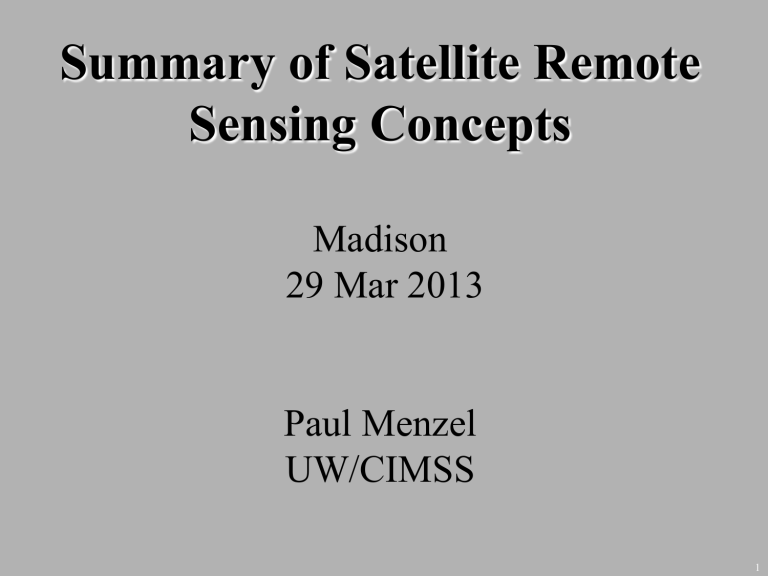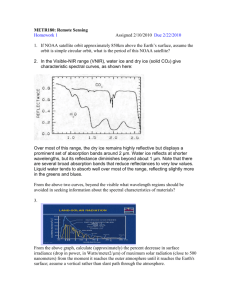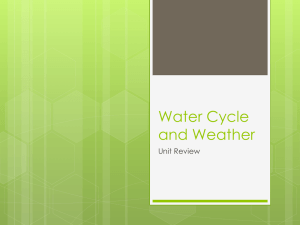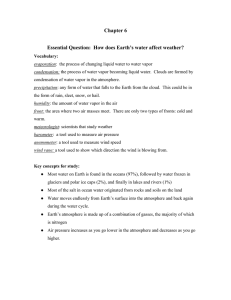Summary of Satellite Remote Sensing Concepts Madison

Summary of Satellite Remote
Sensing Concepts
Madison
29 Mar 2013
Paul Menzel
UW/CIMSS
1
Satellite remote sensing of the Earth-atmosphere
Observations depend on telescope characteristics (resolving power, diffraction)
detector characteristics (signal to noise)
communications bandwidth (bit depth)
spectral intervals (window, absorption band)
time of day (daylight visible)
atmospheric state (T, Q, clouds)
earth surface (Ts, vegetation cover)
2
Radiation and the Planck Function
3
Spectral Characteristics of Energy Sources and Sensing Systems
4
Terminology of radiant energy
Energy from the Earth Atmosphere over time is
Flux which strikes the detector area
Irradiance at a given wavelength interval
Monochromatic
Irradiance over a solid angle on the Earth
Radiance observed by satellite radiometer is described by
The Planck function can be inverted to
Brightness temperature
5
Definitions of Radiation
__________________________________________________________________
QUANTITY SYMBOL UNITS
__________________________________________________________________
Energy
Flux dQ dQ/dt
Joules
Joules/sec = Watts
Irradiance
Monochromatic
Irradiance dQ/dt/dA dQ/dt/dA/d or
dQ/dt/dA/d
Watts/meter
W/m 2 /micron
W/m 2 /cm -1
2
Radiance dQ/dt/dA/d
/d
W/m 2 /micron/ster or dQ/dt/dA/d
/d
W/m 2 /cm -1 /ster
__________________________________________________________________
6
Using wavenumbers c
2
/T
B(
,T) = c
1
3 / [e -1]
(mW/m 2 /ster/cm -1 )
(max in cm-1) = 1.95T
B(
max
,T) ~ T**3.
E =
B(
,T) d
=
T 4 ,
o
T = c
2 c
1
3
/[ln( ______ + 1)]
B
Using wavelengths c
2
/
T
B(
,T) = c
1
/{
5 [e -1] }
(mW/m 2 /ster/
m)
(max in cm)T = 0.2897
B(
max
,T) ~ T**5.
E =
B(
,T) d
=
T 4 ,
o
T = c
2
c
1
/[
ln( ______ + 1)]
5 B
7
B(
max,T)~T 5 B(
max,T)~T 3
Planck Radiances
100
80
60
40
20
0
0
180
160
140
B(
,T)
120
5
B(
,T)
10 15 20 wavenumber (in hundreds)
B(
,T) versus B(
,T)
25 30
8
Spectral Distribution of Energy Radiated from Blackbodies at Various Temperatures
9
Sun Earth
3x10 7 10
VIS IR
W/m2/ster/µm
2x10 -6 2.5x10
-10
MW
10
Area / 3 2x Area /3
11
BT4 – BT11
12
Non-Homogeneous FOV
N
T cold
=220 K
1-N
T hot
=300 K
B=N*B(T cold
)+(1-N)*B(T hot
)
BT = N * T cold
+(1-N)*T hot
Temperature Sensitivity of B(λ,T) for typical earth temperatures
B ( λ, T) / B (λ, 273K)
4 μm
6.7
μm
1
2
10 μm
15 μm microwave
200 250 300
Temperature (K)
Cloud edges and broken clouds appear different in 11 and 4 um images.
T(11)**4=(1-N)*Tclr**4+N*Tcld**4~(1-N)*300**4+N*200**4
T(4)**12=(1-N)*Tclr**12+N*Tcld**12~(1-N)*300**12+N*200**12
Cold part of pixel has more influence for B(11) than B(4)
15
Solar and Earth Radiation
16
Solar (visible) and Earth emitted (infrared) energy
Incoming solar radiation (mostly visible) drives the earth-atmosphere (which emits infrared).
Over the annual cycle, the incoming solar energy that makes it to the earth surface
(about 50 %) is balanced by the outgoing thermal infrared energy emitted through the atmosphere.
The atmosphere transmits, absorbs (by H2O, O2, O3, dust) reflects (by clouds), and scatters (by aerosols) incoming visible; the earth surface absorbs and reflects the transmitted visible. Atmospheric H2O, CO2, and O3 selectively transmit or absorb the outgoing infrared radiation. The outgoing microwave is primarily affected by
H2O and O2.
17
18
19
Spectral Separation
Visible, NIR, & IR
20
Spectral Separation with a Prism: longer wavelengths deflected less
Spectral Separation with a Grating: path difference from slits produces positive and negative wavelet interference on screen
Spectral Separation with an Interferometer path difference
(or delay) from two mirrors produces positive and negative wavelet interference
21
Visible & NIR
22
1
• 36 spectral bands (490 detectors) cover wavelength range from 0.4 to 14.5
m
• Spatial resolution at nadir: 250m (2 bands),
500m (5 bands) and 1000m
• 4 FPAs: VIS, NIR, SMIR, LWIR
• On-Board Calibrators: SD/SDSM, SRCA, and
BB (plus space view)
• 12 bit (0-4095) dynamic range
Velocity
Solar Diffuser SRCA Blackbody
• 2-sided Paddle Wheel Scan Mirror scans 2330 km swath in 1.47 sec
• Day data rate = 10.6 Mbps; night data rate = 3.3
Mbps (100% duty cycle, 50% day and 50% night) Nadir
Fold Mirror
Space
View
Port
VIS NIR S/MWIR LWIR
1 1 1
0
350 400 450 500 550 600
0
600 700 800 900 1000 1100
0
1000 2000 3000 4000 5000
0
6000 8000 10000 12000 14000 16000
23
Visible Infrared Imaging Radiometer Suite
Raytheon SAS El Segundo, Ca
Description
•
Purpose: Global observations of land, ocean, & atmosphere parameters at high temporal resolution (~ daily)
•
Predecessor Instruments: AVHRR, OLS, MODIS, SeaWiFS
•
Approach: Multi-spectral scanning radiometer (22 bands between 0.4 µm and 12 µm) 12-bit quantization
•
Swath width: 3000 km
Spatial Resolution
•
16 bands at 750m
•
5 bands at 325m
•
DNB
VIIRS on NPP
24
Solar Spectrum
26
VIIRS , MODIS , FY-1C , AVHRR
O2
CO2
O2
H2O
O2
H2O
H2O
H2O
H2O
CO2
H2O
27
28
refl 0.85 μm
0.65 μm
0.72 μm
Grass & vegetation
Investigating with Multi-spectral
Combinations
Given the spectral response of a surface or atmospheric feature
Select a part of the spectrum where the reflectance or absorption changes with wavelength e.g. reflection from grass
If 0.65 μm and 0.85 μm channels see the same reflectance than surface viewed is not grass; if 0.85 μm sees considerably higher reflectance than 0.65 μm then surface might be grass
29
John, Becky,
Lisha, Denis
refl
0.65 μm
1.6 μm
Snow and ice
1.4 μm
Investigating with Multi-spectral
Combinations
Given the spectral response of a surface or atmospheric feature
Select a part of the spectrum where the reflectance or absorption changes with wavelength e.g. reflection from snow/ice
If 0.65 μm and 1.6 μm channels see the same reflectance than surface viewed is not snow; if 1.6 μm sees considerably lower reflectance than 0.65 μm then surface might be snow
31
NDSI = [r0.6-r1.6]/[r0.6+r1.6] is near one in snow in Alps
32
Meteosat-8 sees icing in clouds (Lutz et al)
33
IR
34
MODIS IR Spectral Bands
MODIS
35
36
Dust and Cirrus Signals
Imaginary Index of Refraction of Ice and Dust
Ice
Dust
0.8
0.7
0.6
0.5
0.4
0.3
0.2
0.1
0
800 900 1000 1100
Wavenumber (cm
-1
)
12 11
1200
8.6 um
1300
• Both ice and silicate absorption small in 1200 cm -1 window
• In the 800-1000 cm -1 atmospheric window:
Silicate index increases
Ice index decreases with wavenumber
Volz, F.E. : Infrared optical constant of ammonium sulphate, Sahara
Dust, volcanic pumice and flash,
Appl Optics 12 564-658 (1973)
37
SEVIRI sees dust storm over Africa
38
3
1
0.98
0.96
0.94
0.92
0.9
0.88
0.86
7
Spectral features of ice and ash in the 10-13
m waveband
Source: Dr. M. Watson, Michigan Technical University
8
1
0.9
0.8
0.7
0.6
0.5
0.4
0.3
AVHRR channels
1
4 5 transmission (absorption)
0
9 7 1
Wavelength (
m)
0.8
0.7
0.6
0.5
0.4
0.3
0.2
0.1
0
7
0.9
0.8
0.7
0.6
0.5
0.4
0.3
0.2
0
1
0.9
0.8
0.7
0.6
0.5
0.4
0.3
0.2
0.1
0
AVHRR channels transmission (total) transmission (scattering) transmission (absorption) absorption
4 5 scattering total
Ash
7 8 13 transmission (total) transmission (scattering) wavelength
Wavelength (
m) transmission (absorption)
Investigating with Multi-spectral
Combinations
Given the spectral response of a surface or atmospheric feature
Select a part of the spectrum
13 where the reflectance or absorption changes with wavelength
14 e.g. transmission through ash
If 11 μm sees the same or higher BT
8
T
T
10.8
10.8
9
- T
12.0
- T
12.0
10 than 12 μm the atmosphere viewed
12 μm
< 0 volcanic ash
11
11 μm
12
Volcanic Ash does not contain volcanic ash; if 12 μm sees considerably higher
ET-ODRRGOS, Oxford, UK, 1-5 July
14
2002
BT than 11 μm then the atmosphere probably contains volcanic ash
Frank Honey, CSIRO 1980s
39
Volcanic Ash is characterised by low brightness temperatures (i.e. High in the atmosphere) and negative differences in band 31-32.
The emissivity of desert at 12 µm is higher than at
11 µm, and hence BT(12 µm) > BT(11 µm) thus negative values. The red pixels are very arid regions of the desert and are not ash clouds.
40
SEVIRI sees volcanic ash & SO2 and downwind inhibition of convection
Kerkmann, EUMETSAT
41
Radiative Transfer Equation
When reflection from the earth surface is also considered, the RTE for infrared radiation can be written
I
=
sfc B
(T s
)
o
(p s
) +
B
(T(p)) F
(p) [d
p s
(p)/ dp ] dp where
F
(p) = { 1 + (1 -
) [
(p s
) /
(p)] 2 }
The first term is the spectral radiance emitted by the surface and attenuated by the atmosphere, often called the boundary term and the second term is the spectral radiance emitted to space by the atmosphere directly or by reflection from the earth surface.
The atmospheric contribution is the weighted sum of the Planck radiance contribution from each layer, where the weighting function is [ d
(p) / dp ].
This weighting function is an indication of where in the atmosphere the majority of the radiation for a given spectral band comes from.
42
Weighting Function (d
/dlnp)
CO2 channels see different layers in the atmosphere
14.2 um 13.9 um 13.6 um 13.3 um
43
Perpedicular at nadir
Limb darkening
45
MODIS TPW
Clear sky layers of temperature and moisture on 2 June 2001
46
Cloud Mask Tests
• BT11
• BT13.9
• BT6.7
• BT3.9-BT11
• BT11-BT12
• BT8.6-BT11
• BT6.7-BT11 or BT13.9-BT11
• BT11+aPW(BT11-BT12)
• r0.65
• r0.85
• r1.38
• σ(BT11)
• r1.6
• r0.85/r0.65 or NDVI clouds over ocean high clouds high clouds broken or scattered clouds high clouds in tropics ice clouds clouds in polar regions clouds over ocean clouds over land clouds over ocean thin cirrus clouds over snow, ice cloud clouds over vegetation clouds over ocean
47
Ice clouds are revealed with BT8.6-BT11>0 & water clouds and fog show in r0.65
48
High Spectral Resolution IR
49
Vibrational Lines
CO
2
O
3
H
2
O
CO
2
Rotational Lines
CO
2
O
3 H
2
O
CO
2
52
From E. Weisz
53
From E. Weisz
temperature weighting functions sorted by pressure of their peak (blue =
0)
AIRS
On
Aqua
Instrument
• Hyperspectral radiometer with resolution of 0.5 – 2 cm -1
• Extremely well calibrated pre-launch
• Spectral range: 650
– 2700 cm -1
• Associated microwave instruments (AMSU, HSB)
Design
• Grating Spectrometer passively cooled to 160K, stabilized to 30 mK
•
PV and PC HdCdTe focal plane cooled to 60K with redundant active pulse tube cryogenic coolers
•
Focal plane has ~5000 detectors ,
2378 channels. PV detectors (all below 13 microns) are doubly redundant. Two channels per resolution element (n/Dn = 1200)
• 310 K Blackbody and space view provides radiometric calibration
• Paralyene coating on calibration mirror and upwelling radiation provides spectral calibration
•
NEDT (per resolution element) ranges from
0.05K to 0.5K
COLLIMATOR
FOLD MIRROR
FOCAL PLANE
SCHMIDT MIRROR
GRATING
SPHERE
AFOCAL
RELAY
TELESCOPE
ENTRANCE
SLIT
RELAY
EXIT SLIT
FOCAL PLANE
SCAN MIRROR
Grating
Dispersion
HgCdTe FOCAL PLANE
Spectral filters at each entrance slit and over each FPA array isolate color band (grating order) of interest
55
Cross-Track Infrared Sounder (CrIS)
NPOESS Preparatory Satellite – Launch: October 2011
NPP/JPSS
CrIS
•
Michelson Interferometer: 0.625,1.25, 2.5cm
-1
(resolving power of 1000)
•
Spectral range: 660-2600 cm -1
•
3 x 3 HdCdTe focal plane passively cooled
(4-stages) to 85K
• Focal plane 27 detectors,
1305 spectral channels
•
310 K Blackbody and space view
provides radiometric calibration
• NEDT ranges from 0.05 K to 0. 5 K
AIRS
IASI
CrIS
“CrIS LW Noise << AIRS & IASI LW Noise”
AIRS Spectra from around the Globe
20-July-2002 Ascending LW_Window
57
Gregg, Bill, Pei
35_98 59
IASI detection of dust IASI detection of cirrus red spectrum is from nearby clear fov
Dust and Cirrus Signals
Imaginary Index of Refraction of Ice and Dust
Ice
Dust
0.8
0.7
0.6
0.5
0.4
0.3
0.2
0.1
0
800 900 1000 1100 wavenumber
-1
)
1200 1300
• Both ice and silicate absorption small in 1200 cm -1 window
• In the 800-1000 cm -1 atmospheric window:
Silicate index increases
Ice index decreases with wavenumber
Volz, F.E. : Infrared optical constant of ammonium sulphate, Sahara Dust, volcanic pumice and flash, Appl Opt 12
564-658 (1973)
60
IASI detects barren regions
61
IASI sees low level inversion over land
62
Offline-Online in LW IRW showing low level moisture
Red changes less
63
Cld and clr spectra in CO2 absorption separate when weighting functions sink to cloud level
64
MW
65
AMSU-A1
AMSU-A2
MHS
ATMS Design Challenge
Reduce the volume by 3x
• 73x30x61 cm
• 67 W
• 54 kg
• 3-yr life
• 75x70x64 cm
• 24 W
• 50 kg
• 3-yr life
• 75x56x69 cm
• 61 W
• 50 kg
• 4-yr life
Figure courtesy NGES, Azusa, CA
– 70x40x60 cm
– 110 W
– 85 kg
– 8 year life
67
Radiation is governed by Planck’s Law c
2
/
T
B(
,T) = c
1
/{
5 [e -1] }
In microwave region c
2
/λT << 1 so that c
2
/
T e = 1 + c
2
/λT + second order
And classical Rayleigh Jeans radiation equation emerges
B
λ
(T)
[c
1
/ c
2
] [T / λ 4 ]
Radiance is linear function of brightness temperature.
68
Microwave Form of RTE atm
I sfc = ε
λ
B
λ
(T s
)
λ
λ
I
λ
= ε
λ
B
λ
(T s
(p s
) + (1-ε
λ
)
λ
(p s
) + (1-ε
λ
)
λ
p
)
λ
(p
(p s s
)
p
s s
'
B
'
)
B
λ
λ
(T(p))
o
λ
(p) ref atm sfc
ln p
d ln p
λ
(p)
(T(p)) d ln p
o
ln p
o
λ
(p)
p s
__________
+
B
λ
(T(p)) d ln p sfc
ln p
In the microwave region c
2
/λT << 1, so the Planck radiance is linearly proportional to the temperature
B
λ
(T)
[c
1
/ c
2
] [T / λ 4 ]
So
o
T bλ
= ε
λ
T s
(p s
)
λ
(p s
) +
T(p) F
p s
λ
λ
(p)
(p) d ln p
ln p where
F
λ
(p) = { 1 + (1 - ε
λ
(p s
)
λ
) [ ] 2 } .
λ
(p)
69
Scattering of MW radiation
Scattering regimes
AMSU
23.8 dirty window atm Q warms
BT
31.4 window
50.3
GHz
71
Low mist over ocean
T b
= s
T s
(1 m
) + m
T m
+ m
(
1-
s
) (1 m
) T m
So
ΔT b
= - s
m
T s
+ m
T m
+ m
(
1-
s
) (1 m
) T m
For s
~ 0.5 and T s ~
T m this is always positive for 0 < m
< 1
72
MW split window has larger signal for low level moisture than IR split window
73
Moisture
Moisture attenuation in atmospheric windows varies linearly with optical depth.
- k
u
= e = 1 - k
u
For same atmosphere, deviation of brightness temperature from surface temperature is a linear function of absorbing power. Thus moisture corrected SST can inferred by using split window measurements and extrapolating to zero k
Moisture content of atmosphere inferred from slope of linear relation.
74
Accuracy of Satellite Derived Met Parameters
T(p) within 1.5 C of raobs for 1 km layers
SST within 0.5 C of buoys
Q(p) within 15-20% of raobs for 2 km layers
TPW with 3 mm of ground based MW
TO3 within 30 Dobsons of ozone profilers
LI adjusted 3 C lower (for better agreement with raobs) gradients in space and time more reliable than absolute
AMVs within 7 m/s (upper trop) and 5 m/s (lower trop)
CTPs within 50 hPa of lidar determination
Geopotential heights within 20 to 30 m for 500 to 300 hPa
For TC, Psfc within 6 hPa and Vmax within 10 kts
(from MW ΔT250)
Trajectory forecast 72 hour error reduction about 10%
75
Geo vs Leo
76
77
Polar (LEO) & Geostationary (GEO) Orbits
Comparison of geostationary (geo) and low earth orbiting (leo) satellite capabilities
Geo observes process itself
(motion and targets of opportunity) repeat coverage in minutes
(
t
15 minutes) near full earth disk best viewing of tropics & mid-latitudes same viewing angle differing solar illumination visible, NIR, IR imager
(1, 4 km resolution)
IR only sounder
(8 km resolution) filter radiometer diffraction more than leo
Leo observes effects of process repeat coverage twice daily
(
t = 12 hours) global coverage best viewing of poles varying viewing angle same solar illumination visible, NIR, IR imager
(1, 1 km resolution)
IR and microwave sounder
(1, 17, 50 km resolution) filter radiometer, interferometer, and grating spectrometer diffraction less than geo
79
Access to Data and HYDRA
80
Access to visualization tools and data
For hydra2 ftp://ftp.ssec.wisc.edu/rink/hydra2/
For MODIS data and quick browse images http://rapidfire.sci.gsfc.nasa.gov/realtime
For MODIS data http://ladsweb.nascom.nasa.gov/
For AIRS data http://daac.gsfc.nasa.gov
/
For VIIRS, CrIS, and ATMS data, orbit tracks, guide http://www.nsof.class.noaa.gov http://www.ssec.wisc.edu/datacenter/npp/ http://www.class.ncdc.noaa.gov/notification/faq_npp.htm
See tutorial "How do I order NPP data in CLASS (11/28/11)"
81
The Big Picture
82
Key Areas of Uncertainty in Understanding Climate & Global Change
* Earth’s radiation balance and the influence of clouds on radiation and the hydrologic cycle
* Oceanic productivity, circulation and air-sea exchange
* Transformation of greenhouse gases in the lower atmosphere, with emphasis on the carbon cycle
* Changes in land use, land cover and primary productivity, including deforestation
* Sea level variability and impacts of ice sheet volume
* Chemistry of the middle and upper stratosphere, including sources and sinks of stratospheric ozone
* Volcanic eruptions and their role in climate change
83
Trenberth et al, BAMS 2009
84
Major Climate System Elements
Carbon Cycle Water & Energy Cycle
Atmospheric Chemistry
Coupled
Chaotic
Nonlinear
Atmosphere and Ocean
Dynamics
85
Spectral Signatures
86






